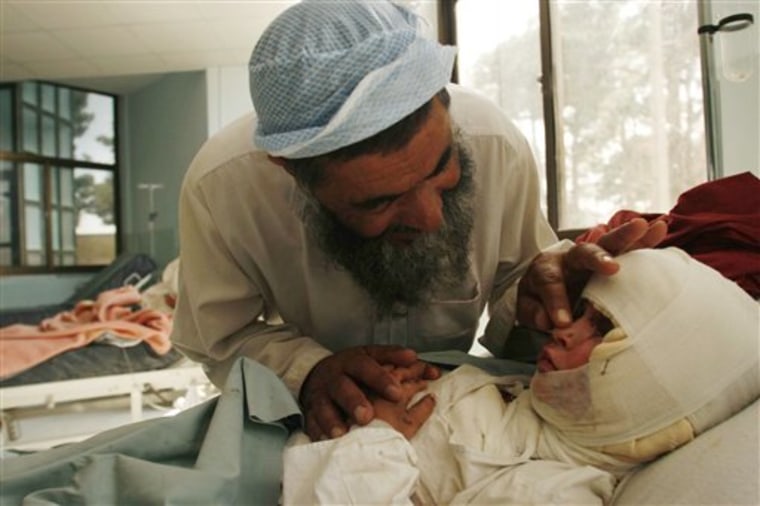The U.S. accused Afghan militants Monday of using white phosphorus as a weapon in "reprehensible" attacks on U.S. forces and in civilian areas.
The accusation comes two months after an 8-year-old Afghan girl named Razia was wounded by white phosphorus in a battle between militants and NATO troops. Razia has received 10 skin grafts at the U.S. military hospital at Bagram. A U.S. military spokeswoman said her injuries could have been caused by either side.
U.S and NATO troops frequently use white phosphorus to illuminate targets and create smoke screens. But human rights groups denounce its use as a weapon, or over populated areas, for the severe burns it causes.
Also Monday, the Pentagon replaced the top U.S. and NATO general in Afghanistan, Gen. David McKiernan, as President Barack Obama tries to turn around a stalemated war. Replacing McKiernan will be Lt. Gen. Stanley McChrystal, who has had a top administrative job at the Joint Chiefs of Staff for less than a year.
Military declassified documents
The U.S. military declassified documents Monday showing at least 38 instances where militants had used white phosphorus in attacks or where weapons had been found in eastern Afghanistan, where the U.S. primarily operates. The NATO-led force supplied information on six other instances in the country.
The U.S. said militants used white phosphorus in improvised explosive attacks at least seven times since spring 2007, some in civilian areas. The documents showed 12 attacks where militants used white phosphorus in mortars or rockets, the majority of which came the last two years.
The most recent militant attack came Thursday, when a NATO outpost in Logar was hit with two rounds of indirect white phosphorus fire, the documents said. Most troops in Logar, just south of Kabul, are American.
Afghan authorities have also said Taliban fighters may have used a burning agent — possibly white phosphorus — in a major battle on May 4, after doctors discovered unusual burns among the dead and wounded. President Hamid Karzai has said up to 130 civilians died in that battle; the U.S. blamed militants for deliberately putting civilians in harm's way.
Doctors are treating 16 patients with severe burns from that battle, said Nader Nadery, an official with the Afghanistan Independent Human Rights Commission.
U.S. says it didn't use white phosphorousCol. Greg Julian, the top U.S. military spokesman in Afghanistan, said the U.S. didn't use white phosphorus in last week's fight in Farah province.
Farah's governor told the Afghanistan Independent Human Rights Commission that many of those killed in the battle had severe burns, Nadery said. The governor said that Taliban fighters may have attacked the villagers with a flammable material, though not necessarily white phosphorus, Nadery said.
The militants' use of white phosphorus as a weapon could cause "unnecessary suffering" as defined in the laws of warfare, U.S. spokeswoman Maj. Jenny Willis said.
"This pattern of irresponsible and indiscriminate use of white phosphorus by insurgents is reprehensible and should be noted by the international human rights community," she said. Willis said the military doesn't necessarily know militants are using white phosphorus deliberately, but that its use is still "indiscriminate."
Militants find white phosphorus rounds in old weapons stores left over from decades of war, she said, but also get newer rounds from "neighbors," a reference to militant networks in Pakistan.
A Taliban spokesman couldn't immediately be reached for comment.
Which side fired the round?
The U.S. allegations come after Human Rights Watch last week called on NATO to release information into a March 14 battle in Kapisa — one province northeast of Kabul, where many French troops are stationed — in which Razia was burned by white phosphorus munitions.
Willis said the NATO-led force can't be certain which side fired the round that wounded Razia.
"Either scenario is possible, and equally regrettable. One thing is certain: Razia will have the best care that we can give her," she said.
White phosphorus may have been used by NATO troops as a smoke screen or to mark targets, Willis said. The release of information about militants' use of white phosphorus was not meant to refute the Human Rights Watch statement, she said.
"We declassified it because there seems to be a general lack of awareness that insurgents are in fact accessing and using white phosphorus, so this is an effort to correct the record," she said. "We're not trying to exonerate ourselves for what happened to Razia, because we just don't know. It could have been our fault."
White phosphorus is not banned by any treaty that the United States has signed.
